Nile Croc Hunted In Homestead As Potential Danger
HOMESTEAD (CBSMiami/AP) — South Florida is no stranger to alligators and crocodiles but the hunt is on for a rare and potentially dangerous Nile crocodile in Homestead and state wildlife officials have given their agents a rare order to shoot to kill.
The Nile crocodile, which hails from Africa, can jump higher, run faster and grow to nearly 20-feet, several feet larger than its American cousin, and has a nastier temperament. And while the American crocodile stays near saltwater like mangroves and estuaries, the Nile crocodile prefers freshwater, making it more likely to come in contact with humans and domestic animals.
Florida Fish and Wildlife Conservation Commission officials said they know of only one Nile croc on the loose, but experts said at least two others have been caught in the same area. The commission is investigating where the croc came from, although it likely escaped from a facility or a local breeder, probably as a hatchling.
"They get big. They're vicious. The animals are just more aggressive and they learn that humans are easy targets," said Joe Wasilewski, a reptile expert and veteran wrangler. The American croc "is a gentle animal, believe it or not. That's their nature. They're more fish eaters. They don't consider humans a prey source."
But the Nile croc currently at large is only a little over three feet long, not dangerous yet. Still, federal wildlife officials have dispatched a team to kill the animal before it becomes a problem. Wildlife officials have tried to capture it with a noose or harpoon, but now realize their only chance to kill it will likely be with a rifle, said FWC nonnative wildlife biologist Jenny Eckles. Only FWC agents are authorized to kill it. If it is caught alive, it will be euthanized.
It's a proactive step in a state plagued by exotic non-native species like the Burmese python, which has overrun the Everglades and upset the delicate ecosystem. Florida has more invasive amphibians and reptiles than anywhere else in the world, and the pet trade is the No. 1 cause, according to a University of Florida study.
No experts believe the Nile crocodile is the next Burmese python, but the python population, which some experts say has grown too big to eliminate, has made them cautious.
"If we don't want to have another Burmese python problem the term is 'early detection and rapid response' and that's what we're doing here," said Frank Mazzotti, a University of Florida professor of wildlife ecology.
His team has spent more than 1,000 hours and endless nights searching by boats and on foot in the canal where the croc was last seen, hoping to spot the red light reflection of its eyes. But Mazzotti said someone captured the reptile in March and let it loose, so the animal is now wary of humans.
Wildlife officials approved killing the crocodile about the same time Hurricane Isaac skirted the state in August. The storm probably sent the crocodile into hiding and it hasn't been spotted since, Mazzotti said.
"We've only had a few instances where these have escaped into the wild. So it would be unlikely they could get established, but we still don't want to have them in our ecosystem," said Eckles.
With reality TV shows glorifying reptile hunting and wrestling, anyone with a penchant for adventure could take the ruling as a license to kill and perhaps mistake the animals.
"They're going to shoot any crocodile or alligator. It will be the Wild West," Wasilewski said.
He sneaked up on and caught a sunbathing Nile croc about six months ago at a park not far from the canal where the other Nile croc was last seen. Wasilewski keeps the roughly 3-foot reptile in a concrete pen with a pool in his yard. He travels the globe lecturing and wrangling reptiles and has a permit to keep them.
Experts say most people can't distinguish between a crocodile and an alligator, let alone differentiate between a Nile and American croc. Alligators are black and have broad, rounded snouts. Crocodiles are grayish and have narrow, tapered snouts.
Niles are dark green or black on top with dark row of spots on the sides. Americans have a lighter olive color with pale yellow sides. The American croc's skull has a distinct median ridge, while the Nile croc's skull is relatively smooth with a slight hump in the center of the snout. But the differences are nearly impossible for the untrained eye to spot.
It's possible but unlikely that the American and Nile crocodile will mate and even less likely the eggs would be viable if they did, Mazzotti said.
Official records on Nile croc sightings in the state are sketchy, but there have been a handful.
Houdini, a nine-foot long, 10-year-old Nile crocodile, escaped from Billie Swamp Safari on Seminole Tribe reservation lands. But he was recaptured a few years ago as part of the "Swamp Men" cable television show and relocated to a facility on Florida's west coast. Seminole Tribe spokesman Gary Bitner said they haven't seen any other Nile crocs on their reservation lands.
"It's a couple of animals. I don't think it's a plague," Wasilewski said.
(TM and © Copyright 2012 CBS Radio Inc. and its relevant subsidiaries. CBS RADIO and EYE Logo TM and Copyright 2012 CBS Broadcasting Inc. Used under license. All Rights Reserved. This material may not be published, broadcast, rewritten, or redistributed. The Associated Press contributed to this report.)



